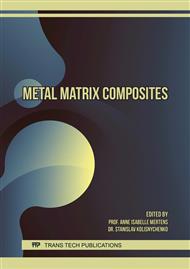p.53
p.59
p.65
p.73
p.79
p.87
p.94
p.100
p.106
Influence of Distinct Manufacturing Processes on the Microstructure of Ni-Based Metal Matrix Composites Submitted to Long Thermal Exposure
Abstract:
Metal Matrix Composites (MMCs) are known for their remarkable properties, by combining materials from different classes. Ni-based MMCs are a promising group of heat-resistant materials, targeting aerospace applications. A discontinuously reinforced Inconel X-750/TiC 15 vol.% MMC was proposed for use in lighter, creep resistant turbine elements, with the aim to endure service temperatures up to 1073 K (800 °C). However, their microstructural stability at high temperatures for long periods of time remained to be further investigated. To address this need, specimens were produced by both conventional hot pressing and spark plasma sintering, using powders milled by low and high energy processes, followed by long isothermal aging. The treatments were conducted at 973 and 1073 K, for times between 50 and 1000 hours. The resulting samples were investigated with XRD and EDS techniques for phase analysis. In addition, measurements of hardness were made to monitor changes in mechanical behavior. It was found that, for each different manufacturing process, the amount, distribution and size of γ’ and other precipitates notably vary during the overaging process. Consequently, the amount of elements kept in solid solution also shifted with time. Furthermore, the study shows how distinct initial microstructures, resulting from diverse fabrication processes, differently impact the microstructural stability over long times of exposure to high temperatures.
Info:
Periodical:
Pages:
79-86
Citation:
Online since:
June 2019
Authors:
Keywords:
Price:
Сopyright:
© 2019 Trans Tech Publications Ltd. All Rights Reserved
Share:
Citation:



